 |
Bo's Memoir " If you don't like something, change it. If you can't change it, change your attitude" (Updated March 29th, 2024) |
I have recently received a lot of new pictures
that I will be working on when I get a chance to update
the three Vietnam era chapters in addition to the
chapters covering my childhood, Cornell, the training
command, my USAF tour, and my tour in Hawaii.
I have just completed the chapters about my tours at COMTHIRDFLEET at Ford Island, Hawaii, as Commanding Officer of VA-174,and as Interim Commanding Officer of FACSFAC Jacksonville. I am working on the chapter about my tour as Executive Officer of USS Saratoga CV-60. Next will be Officer USS Austin LPD-4, Chief of Staff COMCRUDESGRU Twelve (Commander Cruiser Destroyer Group 12), and my final tour in the Navy at CMFAIRWESTPAC (Commander Fleet Air Western Pacific) in Atsugi, Japan.
I have devoted one chapter of the memoir to each of my three combat tours:
I have just completed the chapters about my tours at COMTHIRDFLEET at Ford Island, Hawaii, as Commanding Officer of VA-174,and as Interim Commanding Officer of FACSFAC Jacksonville. I am working on the chapter about my tour as Executive Officer of USS Saratoga CV-60. Next will be Officer USS Austin LPD-4, Chief of Staff COMCRUDESGRU Twelve (Commander Cruiser Destroyer Group 12), and my final tour in the Navy at CMFAIRWESTPAC (Commander Fleet Air Western Pacific) in Atsugi, Japan.
I have devoted one chapter of the memoir to each of my three combat tours:
VA-15 (A4B Skyhawk)
1966:
USS Intrepid CVS-11; Dixie Station/Yankee
Station
(South Vietnam Close and Direct Air Support and Rolling Thunder air operations over North Vietnam)
VA-15 (A4C Skyhawk) 1967: USS Intrepid CVA-11; Yankee Station
(Rolling Thunder air operations over North Vietnam including "Iron Hand" Anti-SAM flights and Alpha Strikes)
VA-82 (A7C Corsair II) 1972: USS America CVA-66; Yankee Station
(Linebacker One air operations over North Vietnam including "Pocket Money" anti-ship mining operations and close air support missions in northern South Vietnam during the bombing halt in North Vietnam between Linebacker One and Linebacker Two)
(South Vietnam Close and Direct Air Support and Rolling Thunder air operations over North Vietnam)
VA-15 (A4C Skyhawk) 1967: USS Intrepid CVA-11; Yankee Station
(Rolling Thunder air operations over North Vietnam including "Iron Hand" Anti-SAM flights and Alpha Strikes)
VA-82 (A7C Corsair II) 1972: USS America CVA-66; Yankee Station
(Linebacker One air operations over North Vietnam including "Pocket Money" anti-ship mining operations and close air support missions in northern South Vietnam during the bombing halt in North Vietnam between Linebacker One and Linebacker Two)
I had significant flight time in
eleven types of aircraft during my flying career.
The following is a poster that Ray Thomas Captain USN Ret, a VA-82 squadron mate, made up for me.
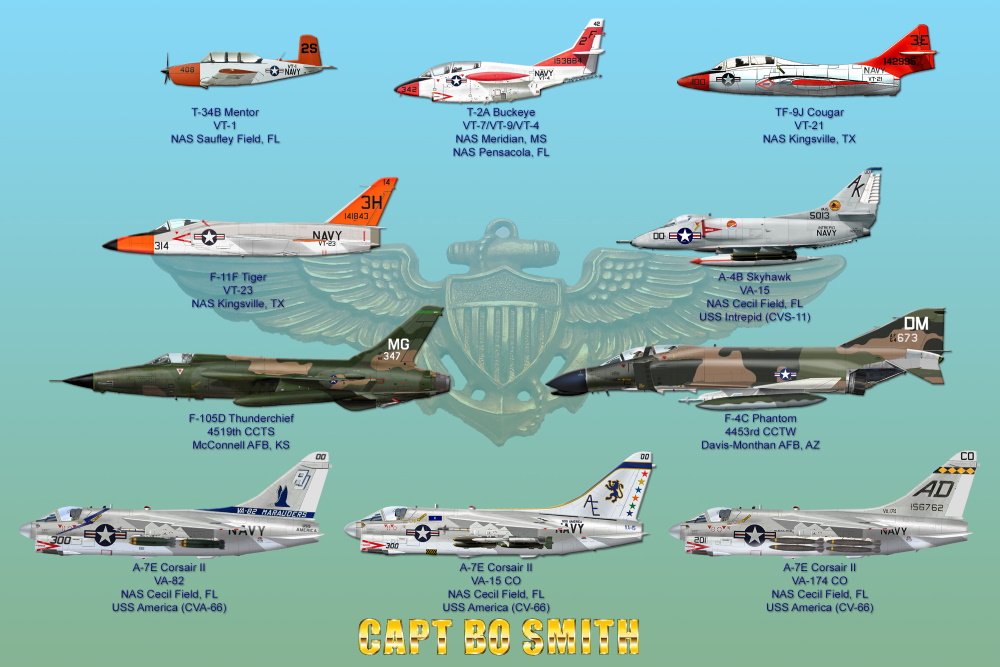 |
| I flew the
four aircraft with the red tails during flight
training; the T-34 at Saufley Field for primary flight
training, the T2A at NAS Meridian and NAS Pensacola
for basic jet training, and the TF9 and AF9 (not
pictured) cougar and F-11 Tiger at NAS Kingsville in
Advanced jet training. I was awarded my "Navy Wings of
Gold" in February, 1965. I flew the A4 Skyhawk in
VA-15 at NAS Cecil Field and on two Vietnam
deployments aboard USS Intrepid CV-11 from 1965
through December, 1967. I flew the AT-33 (not
pictured) and F-105 Thunderchief in the 4519 Combat
Crew Training Squadron at McConnell Air Force Base in
Wichita, Kansas and had a 34 flight our checkout in
the F4 Phantom at Davis Monthan AFB in Tuscon, Arizona
from 1968 through 1970. After checking out in the A7
aircraft in replacement pilot training, I flew the A7E
Corsair in VA-82 at NAS Cecil Field in Jacksonville
Florida with one Mediterranean cruise in 1971 and my
third Vietnam deployment 1972 aboard the USS America
CV-66 fling the A7C. I flew my second tour in the A7E
in VA-15 at Cecil Field with one Mediterranean cruise
in 1977. I was the Commanding Officer of VA-15 from
Dec 1977 through April 1979. We were recognized as the
best Light Attack Squadron on the East Coast with the
Battle "E" during that tour. My third A7 tour was as
the Commanding Officer of the VA-174 Hellrazors at
Cecil. VA-174 was the replacement pilot squadron and
had over 1000 sailors and 100 aircraft. I flew my
2,000 flight hour in the A7B/C/E and the TA7C during
that tour and recorded my 500th carrier arrested
landing (trap) on the USS America during that tour! |
Please remember that this memoir was originally written as a legacy for my family. As a result, it is a bit egocentric as it documents my life's activities and adventures. But, it has also become a record or history from my perspective of the squadrons or ships for the period of time that I was stationed with them. Writing this memoir has required a lot of research, reflection, and reestablishing contacts with former shipmates.
When I flew my Vietnam combat missions, my only concerns were to fly the flight schedule and be an effective combat pilot. The political aspects of the war were not part of my concerns. However, writing my memoir has involved reading numerous accounts of the air war in Vietnam including research in how the political aspects of the war affected our effectiveness thus changing my Memoir in to part journal, part analysis. I used green text to indicate the political stuff. I will use the navy blue text for the material which is related to items of fact or personal observation. I should note that all three of my Vietnam deployments were during the summer monsoon season which featured the best flying weather and consequently the most intense portions of the air war over the north.
In addition to my own recollections and my flight log book, I am using information provided by my squadron mates, then Google and Wikipedia as external sources while writing this memoir. I have also read numerous books about Rolling Thunder (1965-1968), Linebacker One and Two (1972), and about VAL 4 and the OV-10 close air support operations in the Mekong Delta.
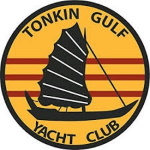 |
Vietnam:
|
Operation Rolling Thunder (1965-1968)- The VALions of VA-15, USS Intrepid (CVS-11):
I completed over 200 Vietnam combat missions in Vietnam in 1966 and 1967. My first Navy fleet squadron was Attack Squadron Fifteen (VA-15).
We deployed aboard USS Intrepid (CVS-11), a World War II vintage aircraft carrier which had been converted from the Anti Submarine Warfare mission (CVS) to conduct Close and Direct air support missions from Dixie Station off the coast of South Vietnam. Intrepid's Carrier Air Wing Ten had three A4B squadrons with 16 aircraft each and two Spad squadrons to accomplish the Dixie Station mission. We normally flew two combat flights a day working with Forward Air Controllers in support of ground operations in the Mekong Delta to areas northwest and east of Saigon. After two line periods from Dixie Station, in early August, 1966, President Johnson wanted a third carrier on Yakkee Station so we were ordered north to Yankee Station to join the Oriskany and Constellation in support of Rolling Thunder missions against North Vietnam. It was tricky business operating an aircraft carrier specifically designed for close air support in a low threat area; no fighter (VF), electronic warfare (EW), or air control aircraft (AEW) in the air wing in the high threat environment of North Vietnam. Our A4B aircraft were not equipped with adequate electronic warfare equipment and were only marginally effective at night. As a result, we flew only day missions which at first were confined to the lower threat coastal areas from south of Vinh to south of Thanh Hoa. However, as we gained experience, we flew missions from Thanh Hoa to Haiphong and occasionally further inland with fighter support usually from the Connie that had F4s.; Oriskany had F8 which were not optiml for BARCAP missons.
Eight months later, on June 21st, 1967, we were back on Yankee Station with USS Intrepid (CVA-11) flying our first missions of our second Vietnam deployment. This time though, we were not the "new guys". We returned with a different CO and XO, but most of the pilots from the first cruise were back and only a couple of "new guys" to break in. We had turned in our 16 A4Bs for 14 A4C Skyhawks properly fitted out with EW gear. During the turnaround training period, we received extensive training in the Russian made AAA and SA-2 Guideline defense systems as we were assigned as the airwing squadron dedicated to fly missions against the SA-2 missile system radars, called Iron Hand missions. In addition, VA-34 from the east coast with 14 A4Cs and a VSF squadron with A4s along with a Spad squadron were part of the mix. our CAG 10 airwing had a detachment of four F8 Crusader fighter aircraft for strike escort and and a few RF-8 reconnaissance aircraft, electronic support aircraft, and airborne early warning aircraft. Our F-8 Crusader fighter aircraft would be limited to providing TARCAP fighter coverage for our strike air craft and escort for our RF8 reconnaissance aircraft. Barrier Combat Air Patrol (MIGCAP) missions for our strikes would be provided by other Yankee Station F4 Phantom fighter squadrons. This time, we would be "in the thick of it" from the start. We were ready and would prove that the USS Intrepid small deck carrier could provide effective air to ground attack missions as well as the large deck carriers.
These are detailed "journal" a style chapters of theses two deployments complete with combat charts, photographs, mission descriptions and even port visits. Here are the links to these chapters:
VA-15 (1965-1966) First USS Intrepid Vietnam Deployment
VA-15 (1967) Second USS Intrepid Second Vietnam Deployment
Operation Linebacker 1 and 2 (summer/fall 1972): The Marauders of VA-82, USS America (CVA-66):
I completed close to 100 combat missions flying the A7C Corsair with the Marauders of VA-82 from the deck of USS America (CV-66) during the summer and fall of 1972. At the beginning of writing this chapter, I remembered very little about that cruise; my third Vietnam tour. But I was able to seek out and reestablished contact with some of my VA-82 Marauder squadron mates; RADM J. Breast, ADM Leighton "Snuffy" Smith, Captain Tom Scott, Jim "Rock" Yeager, Ray Thomas, Charlie Sapp, Jim Kuzmick, Ron Brooks, Marv Baldwin, Gary Tabbert, Terry Ede, Jim Brister, and Nick Nickens, to get their views and comments on some of the missions. I have been able to reconstruct that deployment in some detail. I was able to write up a detailed description of the Battle of Mo Duc which took place on September 17th, 1972, a "Pocket Money" mining mission we (me, Rock, and Ray Thomas) flew near Hon Gay on October 4th, and a major strike mission I lead against the Do Xa bridge near Hanoi on October 5th with "Rock", Dan Ryder, and Ray Thomas. The mission to Hanoi features a two minute audio tape of a salvo of three SA-2 surface to air missiles directed at my lead section.
Here
is the
chapter
about my third
Vietnam
deployment
flying the A7C
Corsair from
the USS
America CVA-66
with the
Marauders of
VA-82.
Books about fighting the Vietnam War in the Mekong Delta in 1969
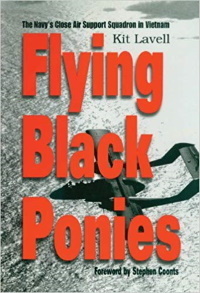 |
It turned out that before reporting to VA-82, Charlie Sapp had a tour of duty in 1969 flying OV-10 Broncos with Light Attack Squadron four (VAL-4) in the Mekong Delta. This mission of VAL 4 was to provide close air support for US Navy River Patrol Boats and Navy Seals various other ground forces when possible. I found that Charlie's stories were very interesting and included some of them the chapter about the VA-82 deployment in the summer of 1972. I recommend you read "Flying Black Ponies" written by Kit Lavell. You will enjoy learning about the significant role the OV-10 made in operations in the Mekong Delta. |
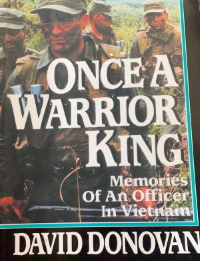 |
You will also enjoy reading David Donovan's book about his experiences as the Military Assistance Team (MAT) 32 Commanding Officer in the Ding Tien District Mekong Delta near the Cambodian border in 1969. The mission of MAT teams was to act as advisors for local Vietnamese forces about how to defend themselves in counter guerilla operations and to provide assistance for local construction or repair projects for schools and other local needs. To accomplish these challenging missions MAT teams consisted usually of only five US Army soldiers: Two officers (a Captain and a 1st Lieutenant) with combat arms backgrounds, two Non Commissioned Officers (NCO) with combat arms background (one heavy weapons and one light weapons expert), and a Medic. |
Click on Vietnam Bibliography for a current list of some other books I have read while writing the chapters about the air war over Vietnam.
I conducted research to understand the political roles that President Lyndon Johnson played in Operation Rolling Thunder (1965-1968) and President Richard Nixon played in Operations Linebacker One and Two (1972).
 |
o really understand President Johnson's life
and political motivation, it is helpful to read
all four volumes of Robert Cato's biography of
Lyndon Johnson. Volume 1. Johnson's early years growing up in the high country of Texas. Volume 2. Johnson's life as a Congressman and his relationship with Speaker of the House, Sam Rayburn Volume 3. Johnson's life as a Senator and his relationship with Senator Richard Russell. Volume 4. "The Passage of Power". President Johnson's goal of passing "Great Society" legislation and his difficulty in coming to terms with his role as Commander in Chief for the Vietnam war. |
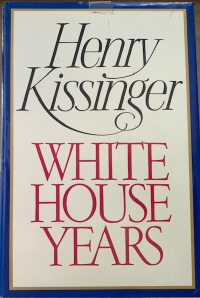 |
To best understand President Richard Nixon's role as Commander in Chief during the Vietnam war, I chose to review it through the eyes of his National Security Advisor, Henry Kissinger in his book "The White House Years". President Nixon understood that the way to limit Russian and Chinese support to North Vietnam was through bilateral negotiations with Russia through things like the SALT talks and through Nixon's eventual expansion of our relations with China with his visit to China in May,1972. |
As I am writing this in some cases almost sixty years after the events occurred, the dates and places are the best I can remember or document in some way. My flight log book provided excellent accurate information in this regard. I am learning that memories that seem clear to me and my friends are not necessarily accurate concerning the place or time that they occurred.
PTSD
During the process of writing this memoir, I have come to believe that the emotionally strenuous times over the skies of North Vietnam during my three deployments and the experience of losing close friends in combat resulted in a type of mild but significant variety of Post Traumatic Stress Disorder (PTSD) known as "emotional numbness". All good carrier combat pilots have to have the ability to compartmentalize; focusing only on the business at hand in order to properly fly the aircraft. This is particularly critical when experiencing inflight emergencies as an incorrect action can cause the loss of the aircraft and possibly the life of the pilot. In combat, it also became necessary to put off grieving for someone who has just been lost in order to continue to fly the mission in progress or the next mission after that. After awhile, you may be unable to outwardly display grief at all. An advantage of this "emotional numbness" is that it is easier to concentrate on those things you can control and ignore those that you cannot. I think that the losses we experienced during my first two Vietnam deployments significantly affected my third Vietnam deployment with VA-82. I was not more cautious; exactly the opposite. I believed that "speed was life" and being aggressive and unpredictable increased my chances of survival. I focused on the missions and was somewhat emotionally detached from my fellow Marauder pilots lest I should loose one of them. I think that is why I had very little memory about that deployment until I reconnected with my VA-82 shipmates while writing my memoir.
This is a relevant excerpt from Mike Spencer's book, "One Man's Journey: The Life, Lessons & Legacy of a World War II Fighter Pilot"
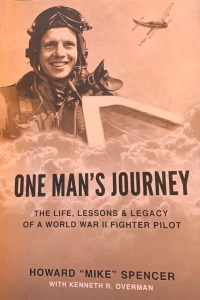 |
After a
pilot was short down, "we all
gathered in the tent and had a
drink in his honor. ..The next
morning, life went on as
though he hadn't been there at
all. That's the way it had to
be. ...Fighter pilots by the
nature of their jobs need to
show little emotion. ... If a
pilot were shot down, we
didn't say, "Oh how awful. I
feel sorry for him". No,
instead we went out and tried
to kill the guy who shot him,
and then we went on with our
lives...My lack of emotion
sometimes surprised me, but I
suppose that was how I coped
with the reality of war. I've read the writings of many philosophers, and several have alluded to the idea that strong people don't get too involved in things over which we have no control. That's the feeling I had about fighter pilots." from page 144 |
So, far, I have read two memoirs written by pilots who flew missions in Europe during World War Two (WW2). One was a B-16 bomber pilot who was shot down over France and spent four months with the French resistance forces which helped him escape (LtCol James Armstrong ASAFR Ret. "Escape: An American Airman's Escape from Hitler's Fortress Europe", 2000). I was able to talk with Jim on a Sunday afternoon in Thomasville, GA. The second was written by a P47 "Thunderbolt" pilot (Mike Spencer, "One Man's Journey", 2018) who flew missions over France and Germany in 1944 and 1945. His Thunderbolt squadron flew primarily air to ground missions. I heard Mike speak at an Association of Naval Aviation lunch. After I read his book, I contacted him and we had lunch. I asked many questions about his combat experiences. We also discussed the process he used to work with a co-author (Kenneth R. Overman) and get his book published. I also read another WW2 memoir, ( Robert S Johnson "Thunderbolt; The Extraordinary Story of a World War II Ace" co-written by Martin Caidin in 1946). This one is also about a P47 Thunderbolt pilot. But in Robert Johnson's case, he few the Thunderbolt against German fighter planes achieving 26 kills without being shot down.
It is interesting to me that although these pilots had many differences, they all had some things in common; mostly rural (farming) backgrounds, all had outdoor experience (hunting, fishing, hiking, and camping) and the P47 pilots had a lot of experience hunting with a 22 caliber rifle which sharpened their eyesight and provided the skills they needed to be good at gunnery in the Thunderbolt. All three were Boy Scouts. All three had become interested in flying early in the childhood by watching barnstormers, air shows, or getting a ride in an airplane at an early age. All three attended church regularly while growing up. Al three enlisted after the Japanese attack on Pearl Harbor on December 7th, 1941 and went through flight training for two years.
My objective in writing this memoir is to reflect upon my life and lessons learned in the process of living it and to provide a historical record for my children and my Navy shipmates. I am also enjoying the challenge of writing it. Conducting the research online, reading relevant books, and providing factual information from my flight log book has required some effort but has been enjoyable. I also have liked the increased contacts I am experiencing with my Navy friends as I seek their comments on my memoir including war stories of their experiences.
After my talk with Mike Spencer about what was involved in working with a co-author/publisher package ($5,000 and Mike recorded his story and the co-author wrote the draft for Mike to edit), I decided to publish it online as part of my personal website. A good aspect of putting it online is that it is a living document and people who read it can correct any errors in content and make suggestions for any additions they might have. I'm not asking you to point out misspellings, typos, or grammatical errors. I want your inputs such as events I have omitted or mistakes in fact that I have made. I hope you will do so and let me know your suggestions by email at:
I am dedicating my memoir to Vice Admiral
Jerry O. Tuttle US Navy Retired. I worked for Jerry Tuttle
while in VA-15 during our 1966 Vietnam deployment. I flew with
him in combat operations in Vietnam in 1966 and 1967 and
observed his leadership style over the years. I did my best
during my naval career to follow his lead on how to identify
and solve problems and run a squadron or ship as a Commanding
Officer. Jerry passed away on October 30th, 2018. VADM
Tuttle was buried in Arlington National Cemetery on Thursday,
March 14th, 2019 after a Catholic Mass was given at the Fort
Myer Post Chapel. A reception followed at the Fort Myer
Officer's Club after the burial. Most of the VA-15 (circa
1966/67) pilots, wives, ex-wives, and widows were present. Tut
always referred to our VA-15 as "none finer". That phrase
"none finer" certainly is a relevant description of of Jerry
Tuttle!
There are a lot of people who contributed significantly to my life over the years. I plan to mention them during the writing of my story on how they positively affected my life. I am relying on my sister, Barbara, who recalls more details about our childhood together with our parents than I do. Jeff Lapic was my best friend during junior high school, Ridgewood High School, during our college years, and during our first few years in the Navy. Captain Jerry L. "Possum" Terrell USN Ret was my shipmate and best friend for over fifty years (1965 to his passing in 2023. Possum was with me at my best and worst times; always positive and supportive. Unfortunately, Possum passed away last ear.
Marianne and Lehman Barnes were colleagues during my educator days and continue to be friends to this day. My wife Diana and I are members of the New Day JAX Church in Jacksonville. Although we no longer can attend services in person, we enjoy the fellowship, music, and message we experience with this group via texts emails, and Zoom when available..
I have had three wives over the course of my life. All of them have been a significant factor in my life. My first wife Mary (1963-1978), is the mother of my first three daughters; Heather, Laura, and Stacy. She was married to me during all three of my Vietnam combat tours. She kept the "home fires burning" during my sea duty tours. My second wife Cathy (1978-2000), is the mother of my fourth and fifth daughters; Jessica and Lindsay. She divorced me after I retired from the Navy and decided to pursue my second career in education instead of flying for the airlines. I have been married to my third wife, Diana, for almost sixteen years now (August 2008 to present). Diana and I enjoy our life together in Jacksonville, Florida.
You can find additional information about me in addition to this memoir on my website at: http://bo-smith.net.
There are a lot of people who contributed significantly to my life over the years. I plan to mention them during the writing of my story on how they positively affected my life. I am relying on my sister, Barbara, who recalls more details about our childhood together with our parents than I do. Jeff Lapic was my best friend during junior high school, Ridgewood High School, during our college years, and during our first few years in the Navy. Captain Jerry L. "Possum" Terrell USN Ret was my shipmate and best friend for over fifty years (1965 to his passing in 2023. Possum was with me at my best and worst times; always positive and supportive. Unfortunately, Possum passed away last ear.
Marianne and Lehman Barnes were colleagues during my educator days and continue to be friends to this day. My wife Diana and I are members of the New Day JAX Church in Jacksonville. Although we no longer can attend services in person, we enjoy the fellowship, music, and message we experience with this group via texts emails, and Zoom when available..
I have had three wives over the course of my life. All of them have been a significant factor in my life. My first wife Mary (1963-1978), is the mother of my first three daughters; Heather, Laura, and Stacy. She was married to me during all three of my Vietnam combat tours. She kept the "home fires burning" during my sea duty tours. My second wife Cathy (1978-2000), is the mother of my fourth and fifth daughters; Jessica and Lindsay. She divorced me after I retired from the Navy and decided to pursue my second career in education instead of flying for the airlines. I have been married to my third wife, Diana, for almost sixteen years now (August 2008 to present). Diana and I enjoy our life together in Jacksonville, Florida.
You can find additional information about me in addition to this memoir on my website at: http://bo-smith.net.
Chapters
| Childhood through High School (1941-1959) |
Cornell University (1959-1963) |
Navy Flight
Training (1963-1965) |
| Maintenance Officer's School Memphis VA-45 and VA-44 NAS Cecil Field, Jacksonville (February 1965-October 1965) |
VA-15 (1965-1966) First Vietnam Deployment USS Intrepid CVS-11 Dixie Station/Yankee Station (109 combat missions) (June 1966- October 1966) |
VA-15 (1967) Second Vietnam Deployment USS Intrepid CVA-11 Yankee Station, Tonkin Gulf (94 combat missions- total 203) 300 Total Intrepid Traps (November 1966-November 1967) |
US Air Force Exchange Tour AT-33 Instructor/F4 Phantom/ F105 Thunderchief Instructor Pilot McConnell AFB, Wichita, Kansas (March 1968-March 1970) |
VA-82 A7 Corsair Tour-1971 1971 Mediterranean Cruise (July 1971-December 1971) USS America CV-66 |
VA-82 A7 Corsair Tour-1972 Third Vietnam Combat Deployment Yankee Station, Tonkin Gulf (June 1972-December 1972) (102 combat missions) USS America CV-66 |
Royal Air Force Staff College Bracknell, Barkshire, England (January 1973-February 1974) |
COMNAVAIRLANT Staff Tour Norfolk, Virginia (March 1974- February 1976) A7 Class Desk Officer Aide and Flag Lieutenant |
VA-15 Executive Officer
Commanding Officer (1976-1979) USS America CV-66 Med Deployment (Dec 1977-April 1979) COMNAVAIRLANT Battle "E" |
| COMTHIRDFLEET Staff Tour Ford Island, Oahu, Hawaii Air Training Officer (May 1979-December, 1980) Planned and flew in Battle Group Hawaiian transit exercises, two Eastern Pacific Fleet Exercises, and a RIMPAC (Rim of the Pacific) Exercise |
Commanding Officer VA-174 NAS Cecil Field Jacksonville, Florida (March 1981-July,1982) Completed the Surface Warfare Prospective Commanding Officer Course, SWOSCOLCOM, Newport (July,1982- October,1982) |
Interim Commanding Officer FACSFAC Jacksonville (October 9th, 1982-June 9th, 1983) Continued deep draft ship training program on TAD basis Idaho Falls Ship Material Course (Feb1984-May 1984) Completed deep draft ship training program SWOSCOLCOM, Newport |
| Executive Officer USS Saratoga (CV-60) Med Deployment (1984) |
Commanding
Officer USS Austin (LPD-4) (July1985-July 1987) Med Deployment-May 85-Nov 85 Northern Wedding/Med Deployment (1986-1987) |
Chief of Staff COMCRUDESGROUP 12 USS Eisenhower CV-69 Deployment (1989) |
| COMFAIRWESTPAC Operations Officer COMORANGE- 7th Fleet Atsugi, Japan (1990-1991) Special Assignment Desert Shield (Aug-Sep 1990) |
Retired as
Captain US Navy July 31st, 1991 Total Tactical Jet Hours- 4060 Total CV Landings- 980 Total Combat Missions- 305 Nine Deployments |
Educator (1991-2007) Terry Parker High School University of North Florida Program Manager, Protein Crystals in Space in Florida Schools Florida Space Research Institute (Aerospace Education Mentor) |
"War is an ugly thing, but not the ugliest of things. The decayed and degraded state of moral and patriotic feeling which thinks nothing is worth war is much worse. The person who has nothing for which he is wiling to fight,nothing that is more important than his own personal safety, is a miserable creature and has no chance of being free unless made and kept so by the exertions of better men than himself."
John Stuart
Mill
Website Created by Robert S. "Bo" Smith